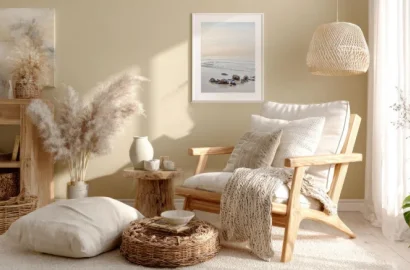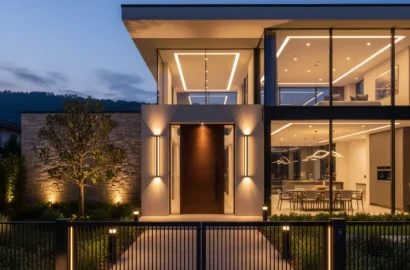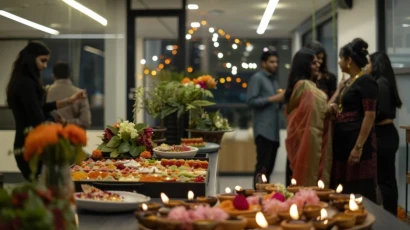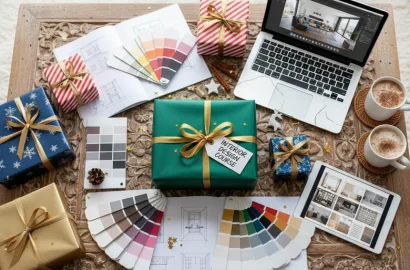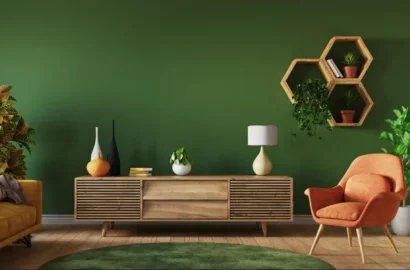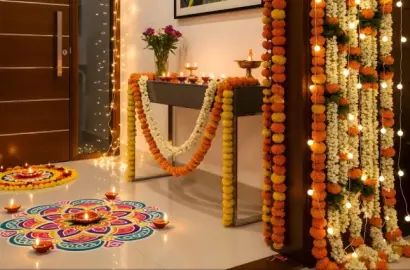What are interior design principles and how do you apply them? We’ve got everything you need to know in this guide, from the theory of these principles to their practical application.
Have you ever wondered what foundational guidelines interior designers use to create visually appealing, functional homes that cater to the needs and preferences of their occupants? In this article, we’ll be introducing you to interior design principles, the very basis of this design discipline. These principles–balance, harmony, rhythm, proportion, contrast, emphasis, and functionality–support interior designers and homeowners alike in designing beautiful rooms that work together cohesively while still fully serving their intended purposes.
In this guide, we’ll be exploring each one of these principles and offering practical tips on how you apply them to the rooms in your own home. By the end, you’ll be confident in creating spaces that aren’t just beautiful, but highly functional and comfortable, too.
Contents:
- The importance of interior design principles
- Key interior design principles
- Practical tips for applying interior design principles
- Conclusion
Let’s dive in!
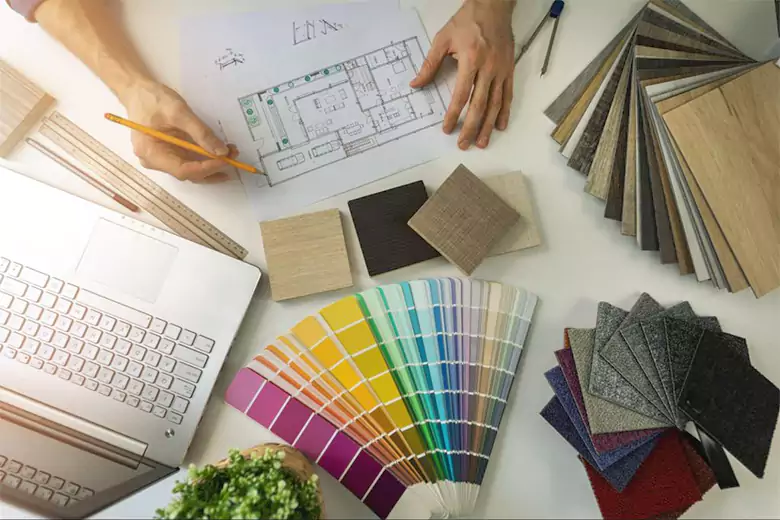
The importance of interior design principles
Interior design principles are base guidelines and advice that support interior designers and homeowners in creating thoughtfully decorated homes and spaces. The primary purpose of these principles is to support the design of rooms and homes that don’t just look great, but also serve their intended function. They do this by balancing form and function: promoting a cohesive aesthetic that ensures all the design elements–furniture, furnishings, color palettes, materials, and accessories–complement each other aesthetically and work together practically.
When these principles are applied, it helps enhance the comfort and usability of a room without mitigating personal expression. Indeed, the principles actively encourage the incorporation of design elements that reflect the occupant’s personal interior design style and practical needs, encouraging the highlighting of key features and interesting focal points. Ultimately, interior design principles are essential to ensuring a space is functional, comfortable, and attractive while enhancing the quality of life for occupants.
Key interior design principles
We’re now going to run through the seven interior design principles that interior designers use to create beautiful yet functional spaces. We’ll also be offering practical tips on how you can apply these principles in your own home.
1. Balance
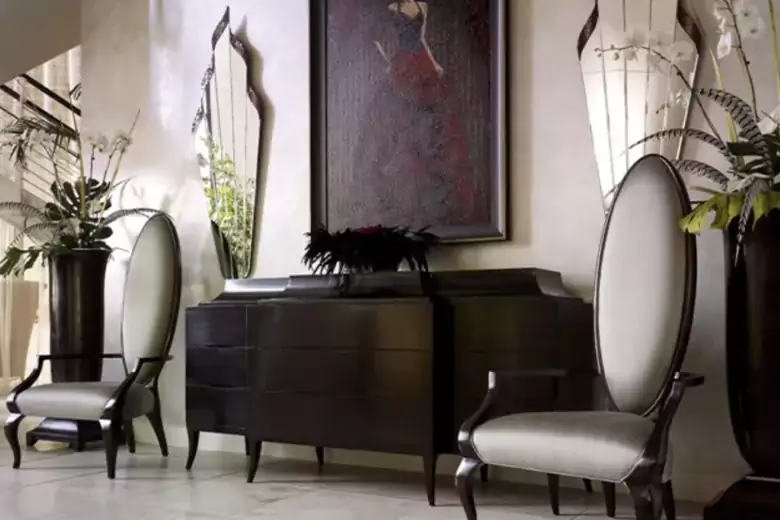
Balance is a primary principle in interior design. The term refers to how visual weight is distributed throughout a room in order to ensure that no one area is neither overcrowded nor underdeveloped. To achieve balance in a room, an interior designer needs to think about more than just how furniture and objects are distributed. What is also important is creating an overall feeling of harmony and proportion.
Types of balance
There are three main types of balance that designers consider when drawing up their designs: symmetrical, asymmetrical, and radial balance.
Symmetrical balance
Symmetrical balance refers to when the visual weight of the interior is evenly distributed on either side of one central point. When a room has been designed with symmetrical balance in mind, it typically feels organized and harmonious, with no one area feeling too “heavy”, or cluttered.
Radial balance
Radial balance is when design elements are arranged around a central point. This type of balance works particularly well in round spaces. An example of radial balance might be when, in a dining room, a round table with chairs placed around it is positioned in the center of the room, drawing in the eye.
Asymmetrical balance
In contrast to symmetrical balance, asymmetrical balance sees designers distribute furniture, accessories, and decor unevenly throughout the room, irrespective of contrast, color, or size. More common in contemporary interior design, this approach creates a more informal, albeit organized, feel.
How to apply balance
With an eye on harmony and visual equilibrium, applying balance in interior design typically starts with considering the size and weight of the objects in the room.
- For symmetrical balance consider placing matching furniture on either side of a central object like a coffee table.
- For asymmetrical balance, combine differently sized or shaped items that balance each other out through their color, texture, or weight. Eg., A large sofa on one side of a living room can be balanced out with two smaller armchairs and some large plants on the other side.
- To achieve radial balance, arrange furniture and objects around a central point like a round dining table or a large circular rug.
2. Harmony
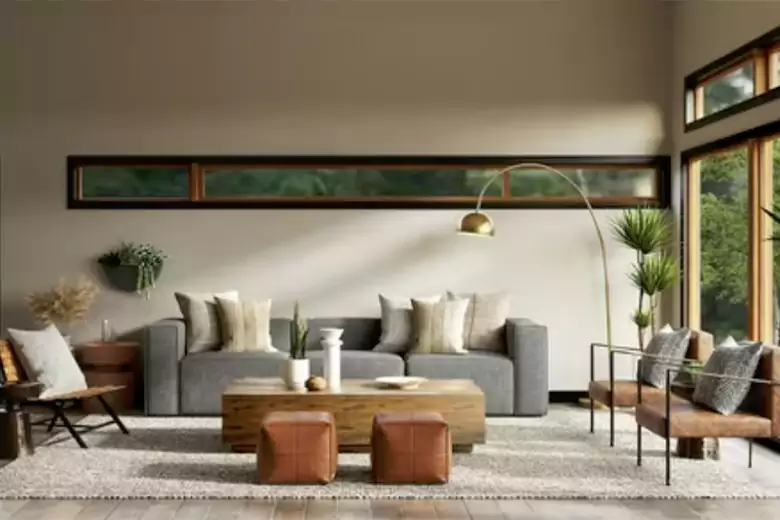
While we probably all aspire to have harmonious homes, when we talk about harmony in interior design we are referring to the creation of a cohesive space in which all elements complement each other to evoke a sense of peace. In such an environment, no single design element should look or feel out of place or disrupt the overall aesthetic. In addition to selecting and arranging pieces of furniture complementing each other, harmony also refers to the seamless flow between spaces. Occupants should have the freedom to move and interact with ease through the space without coming up against barriers or objects.
How to apply harmony
With a focus on creating a unified space, some simple ways to adhere to this principle include:
- Selecting a unified color scheme for the room. This means choosing complimentary colors that enhance visual cohesion. You might even opt for a single base hue and add accent colors to the space via accessories.
- Repeating patterns or textures. For example, if you have a monochrome pattern on a rug, you might wish to repeat that on curtains or cushions.
- Blending materials while keeping balance in mind. For example, a velvet chair would work well with a glossy coffee table.
- Don’t forget proportions and scale. Ensure that all furniture pieces are scaled to fit the room they’re intended for and the furniture they’re next to.
3. Rhythm
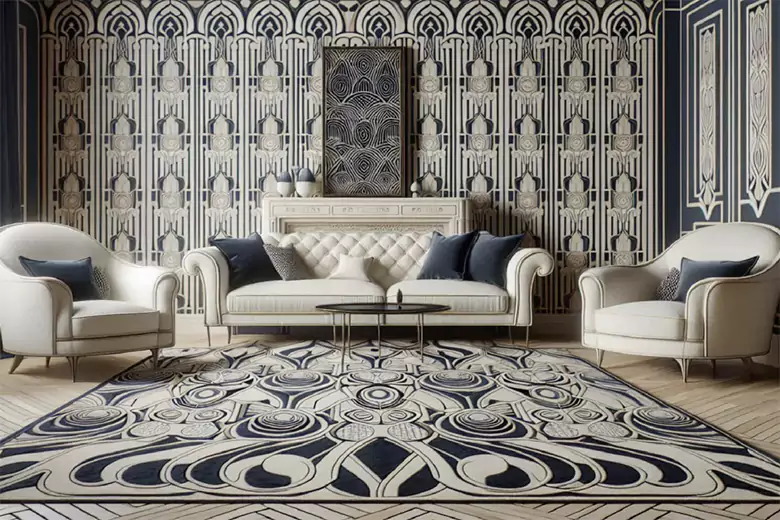
While we might not naturally associate the word ‘rhythm’ with interior design, in this context the word refers to repeating design elements like patterns, textures, colors, and shapes that create a sense of movement and flow. Progression of elements also plays a role here. This refers to when objects gradually change size, color, or shape, leading occupants naturally from one area of the room to another. Rhythm is an important interior design principle because it ensures that a room feels dynamic and connected.
How to apply rhythm
Some simple ways to include rhythm in your interior design practice include focusing on patterns and repetition. You can do this by:
- Repeating elements such as colors and shapes to create a rhythmic flow. Tie the room together by selecting throw pillows and lampshades in the same hue, for example.
- Gradually changing an element, like a color or a shape, to give the impression of movement or progression.
- Mix together alternating patterns consistently to bring a dynamic feel to the space that doesn’t overwhelm the eye. Try to ensure that there is a common color or theme in all patterns that you choose.
4. Proportion and scale
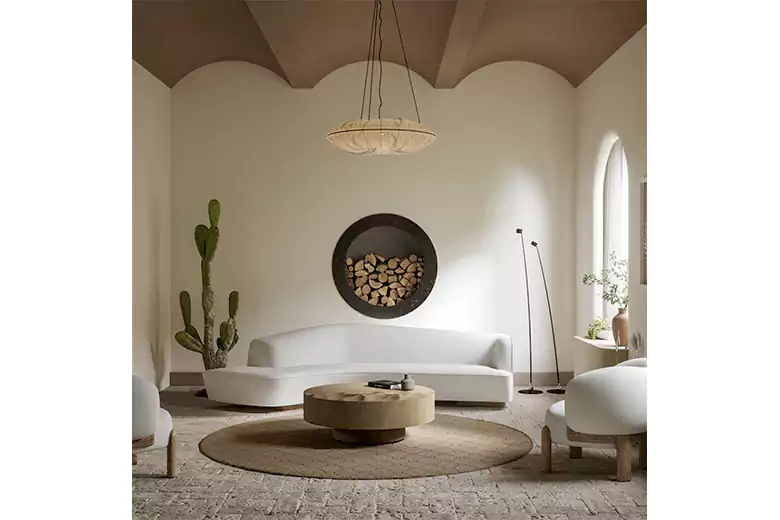
In order to ensure that furniture, architectural elements, decor, and accessories are well-matched to the size of the room, proportion and scale need to be taken into account at every stage of a design. While proportion describes the relationship between the sizes of different design pieces, scale refers to the size of an object in relation to its immediate surroundings. Interior designers have to carefully consider both proportion and scale when bringing together the different design elements of a room for it to be functional, attractive, and comfortable for occupants.
How to apply proportion and scale
Some best practices for incorporating proportion and scale into your interior designs include:
- Considering room size when selecting furniture. Avoid oversized furniture in small spaces and be mindful of including tiny furniture in very large spaces.
- Ensuring large pieces of furniture take up no more than around two-thirds of the length or width of the room.
- If you have high ceilings, arrange both tall and small pieces of furniture throughout the space to avoid creating a room that feels top-heavy. Wide rooms also benefit from long, low pieces of furniture.
5. Contrast
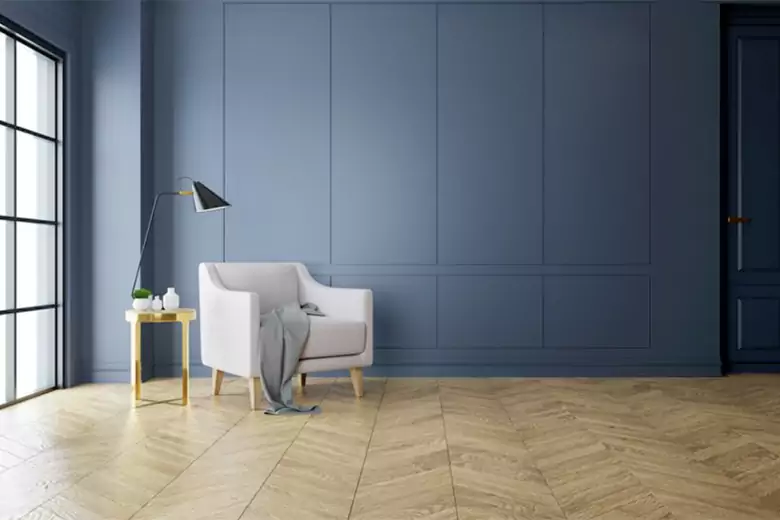
Using contrast in interior design is a powerful tool that sees different elements placed close to one another to emphasize certain aspects of the space and create strong focal points. While this can be simply achieved using paint color or furniture size, the look can be effectively created using different textures and materials, too. Balance plays a pivotal role when incorporating contrast into your interior design. You want a room to feel dynamic, even bold, but you don’t want it to be overwhelming or uncomfortable. When you are thoughtful with how and when you use contrast it will add depth and visual appeal to your space, drawing attention only to the areas that you want it to.
How to apply contrast
Tips for including contrast include:
- Using color combinations to create contrast. Put dark tones next to lighter shades, or try out complimentary colors close to contrasting tones.
- Mixing rough and smooth textures to add depth with contrast. Think about bringing together soft fabrics with hard materials for a balanced contrast.
- Bring together different shapes and sizes with furniture and accessories. Consider pairing a large oval dining table with sharp-edged chairs.
6. Emphasis
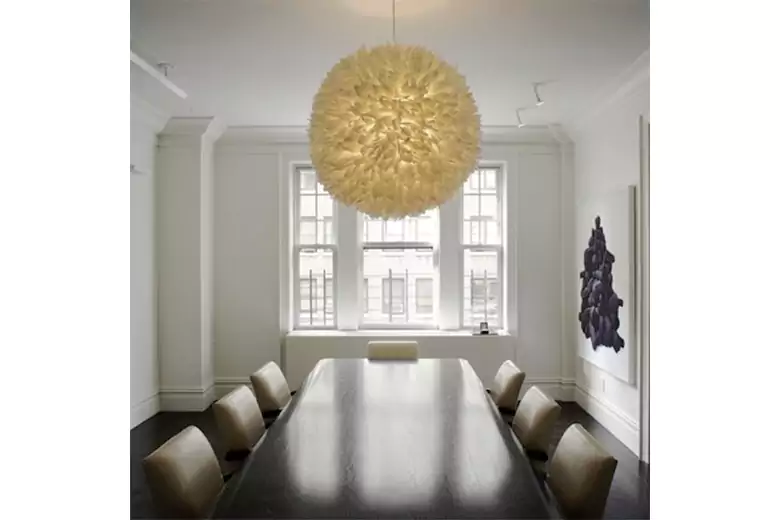
The emphasis principle refers to creating a point of visual interest within a space such as a feature wall, a fireplace, a piece of statement furniture, a sculpture, or statement lighting. When the emphasis principle is applied, the designer seeks to draw attention to one or more of these key elements. When specific features are emphasized using lighting, color choices, and furniture placement, the room is given a clear sense of purpose without mitigating the cohesion of the design.
How to apply emphasis
Some ideas for how to apply emphasis:
- Create a feature wall. This might be a wall painted in a bold color or decorated with wood paneling.
- Invest in a statement chandelier or pendant light. This will draw attention to the lamp itself as well as the space beneath it when it’s turned on.
- Select statement furniture such as a brightly-colored sofa, sculptural armchair, or antique coffee table to make a focal point for the room.
7. Functionality
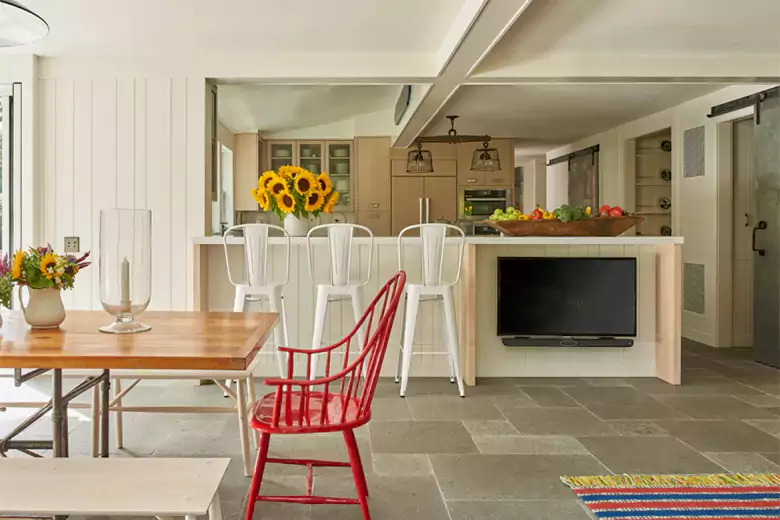
A beautiful room is useless if it doesn’t meet the needs and expectations of its users. That’s why functionality is one of the most important interior design principles. It states that a room should not just be pleasing to the eye but also practical, comfortable, convenient, and livable. When the functionality principle is applied in interior design, spaces become more efficient, organized, and tailored to the needs of the people who use them.
How to apply functionality
To ensure that the room you are designing is set up to support occupants in completing their everyday tasks easily and in comfort, try out these strategies for achieving full functionality:
- Think about the purpose of the room. If it’s a small kitchen you’ll want to prioritize workflow and easy access to appliances, whereas in a living room, you’ll want to ensure optimal cosiness and sociability.
- Enhance your storage options to keep the room well-organized. You can do this by utilizing built-in shelves and multi-functional furniture.
- Prioritize comfort and access. Incorporate ergonomic furniture and adjustable lighting to help all occupants feel comfortable and in control.
Practical tips for applying interior design principles
Consider using these ideas and tips to prioritize interior design principles.
1. Color and texture
When you’re thinking about how to apply the principles of balance, harmony, and contrast in your home, color schemes and textures are great tools.
Try out these ideas:
- To achieve balance, distribute colors and textures evenly throughout the room.
- To ensure harmony, select a cohesive color palette of complementary colors, and harmonize textures by pairing contrasting materials.
- To introduce contrast, be experimental with opposites. For example, pair rich textures with light colors or mix bold patterns with blocks of color.
2. Furniture layout
How you select and arrange the furniture in a room will establish the dynamic of the space. To incorporate the rhythm principle of interior design, repeat furniture styles and shapes such as round tables and circular lampshades, while for the scale principle, select furniture that is proportional to the size of the room. Ensure adequate spacing between design elements to allow for seamless movement that will still enable you to maintain a balanced composition.
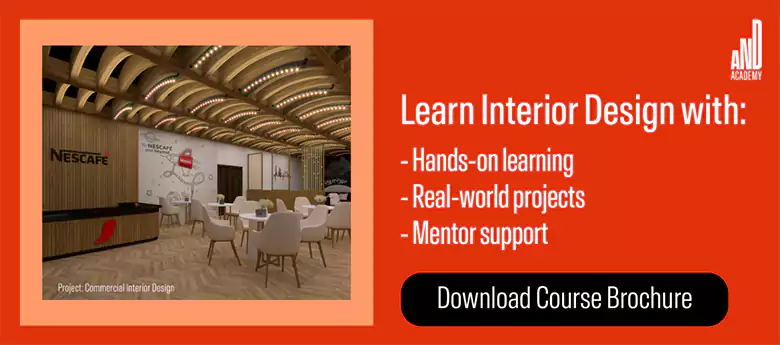
Conclusion
And there you have it! The seven principles of interior design and how to apply them. We hope that by understanding these principles and their practical application, you can make the rooms in your home inviting, cohesive, and functional for all occupants. Remember, the key to successful interior design is to combine aesthetics with functionality. Your space should look great, and act as a true reflection of your personal taste and style, but, crucially, it should also serve all of your practical needs. When you keep all of these principles in mind, you can be sure to enhance both the comfort and livability of your home.
For more interior design articles like this one, head back to the AND Academy blog! You can also check out this project by AND Learner, Sunali Khajuria to further understand how interior design principles are applied in real life.
Next Steps
In case you need further assistance, here are some resources to consider:
- Watch this session by Snehanshu Mukherjee, Founding Partner at T.E.A.M and Mansi Almadi, an Interior Designer at Studio Lotus
- Talk to a course advisor to discuss how you can transform your career with one of our courses.
- Check out our Interior Design courses - all courses are taught through live, interactive classes by industry experts.
- Take advantage of our scholarship and funding options to overcome any financial hurdle on the path of your career transformation.
Note: All information and/or data from external sources is believed to be accurate as of the date of publication.




